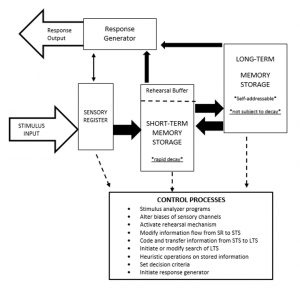57 Cognitivism
Cognitivism
Psychology as a science is thought to have begun in 1879 when Wilhelm Wundt established the first psychology laboratory in Leipzig, Germany. The method of inquiry about the mind that Wundt used was subjective introspection. Since the mind was explored using a tool of self-observation, this method is considered central to the cognitive approach of study. Winn and Snyder (1996) claimed that Wundt’s methodological contribution was “the development of introspection as a means for studying the mind”. Unlike Behaviorism, which posits that humans actions are nothing more than conditioned behaviors with no invisible “mind”, cognitivism relies heavily on the idea that the conscious mind is its own independently functioning unit. Cognitivism focuses on inner mental activities, so looking inside the mind is essential in order to understand the process of human learning. Learners themselves are seen as living informational processing systems.
Research in cognitive psychology has put effort into developing support for the mechanisms that control how new information is processed in the mind (Barsalou, 1992). Different constructs dealing with memory storage and retrieval have been used to describing information processing. The specifics of these constructs delve into how humans process information, which environmental information is salient enough to be stored in memory, which information can be retrieved from memory, and what information from our memory shapes interactions and behaviors. Much like computers, people acquire all of their new information from the environment. Both people and computers store information that has been processed from interactions and then retrieve whatever information is applicable to current tasks. Also, both humans and computers are limited in the amount of information they can process or store at a given time.
The most widely accepted theory about the specifics of the “human computer” mind is stage theory, which is based on the work of Atkinson and Shiffrin (1968). The stage model assumes that the nervous system works as a circuit of stages that processes information in the environment from the initial input to storage in long-term memory. The three main stages each consist of a different psychological construct: sensory registers, short-term memory, and long-term memory. Each of these constructs is independently capable of influencing our response to the environment.
The figure below is adapted from Atkinson and Shiffrin (1968), and it shows a model of how the sensory registers, short-term memory, long-term memory, and responses to the environment are all related.

- Sensory Registers: They briefly store representations of external stimuli from the environment until the information can be transferred further. Each one of the different senses has a different sensory register. Unless the information that is being temporarily held here is quickly passed on to short-term memory, it will be lost. For example, we are not always aware of all of the visual stimuli going to our eyes or the feeling of the skin on our legs when we are sitting in a chair. Only what is thought to be meaningful external information is passed on to short-term memory.
- Short-term Memory: This can be thought of as conscious memory. Not only does it hold onto information, but it can also interpret, manipulate, and transform it. If it is processed correctly here, the information may be transferred to long-term memory.
- Long-term Memory: This is a relatively unlimited and permanent repository of information. Long-term memory stores information for later use. This information no longer has to be actively presented in the environment or conscious to the mind in order to remain in this storage. Once the information is stored in the long-term memory, it stays.
Implications for the Classroom
Sweller’s (1988) theory of cognitive load, which is based on Miller’s (1956) work on information processing, puts forth the idea that an individual’s knowledge base is made up of cognitive structures called schemas, which get more complex as we become more advanced learners. Because novice learners have fewer schemas, their working memory is taxed more than an advanced learner. Creating external supporting structures for information through chunking, activating prior knowledge, and providing worked examples are all ways to reduce cognitive load.
Both teacher and students can utilize cognitive strategies which can significantly impact learning outcomes. LuAnn Jordan (University of North Carolina, Charlotte) listed some different teaching strategies relative to cognitivism. The following are examples of different tricks and strategies for processing information into long-term memory:
- Rehearsing target information by visualization and verbalization
- Practicing vocabulary information through a game or students quizzing each other
- Creating phrases or making analogies
- Simplifying complex information (i.e. creating acronyms, rhymes, or anecdotes)
- Creating a visualization of a process via drawing or some other tangible means
- Transforming target information by relating a cue word, phrase, or sentence (i.e. My Dear Aunt Sally is used for the order of mathematical functions – multiply, divide, add, subtract)
Here are other few tips on how to organize information in lectures and notes in order to facilitate learning:
- Draw student attention to important points through highlighted information
- Teachers cue students to “listen carefully”
- Use eye-catching figures and displays to attract attention
- Categorize, sequence, and organize information so that it may be easily related and recalled
- Provide examples of useful mnemonics
Teaching Strategies that support this Learning Theory
Technology Tools that support this Learning Theory
In the Library
Atkinson, R. C., & Shiffrin, R. M. (1968). Human memory: A proposed system and its control processes. Psychology of Learning and Motivation, 2, 89–195.
Barsalou, L. (1992). Cognitive psychology: An overview for cognitive scientists. Lawrence Erlbaum Associates. ISBN 978-0898599664.
Wilson, B. G., & Myers, K. M. (2000). Situated cognition in theoretical and practical context. Theoretical Foundations of Learning Environments, 57–88.
Winn, W., & Snyder, D. (1996). Cognitive perspectives in psychology. In D. Jonassen (Ed.), Handbook of research for educational communications and technology (pp. 112-142). New York: Macmillan

